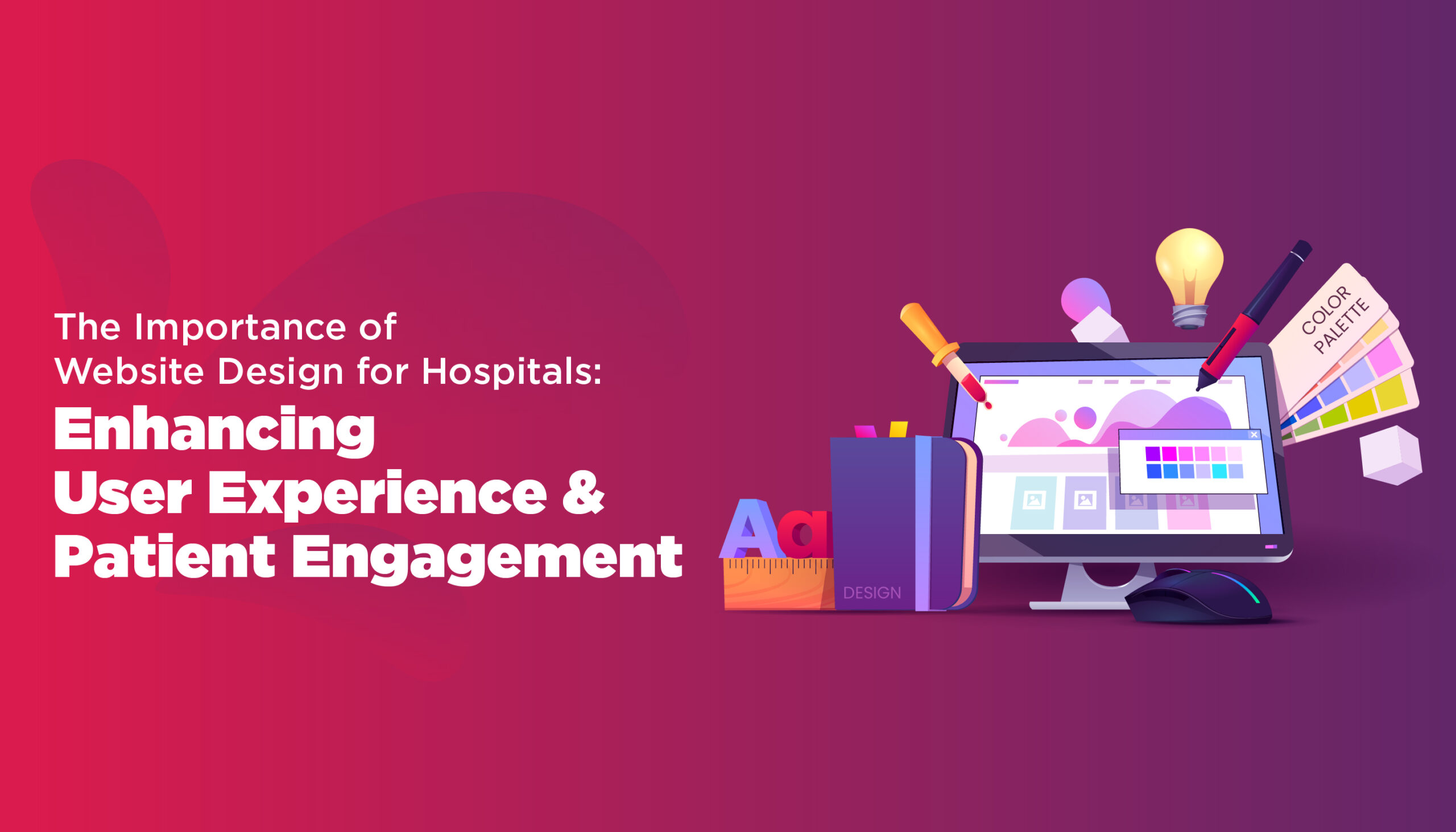
The Importance of Website Design for Hospitals: Enhancing User Experience and Patient Engagement
In today’s digital age, a hospital’s website serves as the virtual front door for patients seeking healthcare information and services. An effective website design plays a crucial role in enhancing user experience and patient engagement.
By incorporating user centred design principles, responsive layouts, intuitive navigation, and engaging multimedia, hospitals can create a digital platform that fosters trust, empowers patients, and delivers an exceptional online experience. This article explores the significance of website design in the healthcare industry and highlights the benefits it brings to both patients and hospitals.
Enhancing User Experience
A user centered design approach is paramount when creating hospital websites. By understanding the needs, preferences, and behaviours of patients, hospitals can tailor their websites to provide a seamless user experience. Clear navigation menus, intuitive interface design, and well-organized content enable visitors to easily find the information they seek.
A responsive and mobile friendly design ensures that the website is accessible and functional across various devices, including smartphones and tablets. This adaptability allows patients to access healthcare information on the go, leading to increased convenience and engagement.
Visual design and multimedia integration play a vital role in capturing users attention and conveying information effectively. Incorporating engaging visuals, such as high-quality images, videos, and infographics, can help simplify complex medical concepts and create an immersive experience for visitors.
Additionally, integrating multimedia elements like virtual tours, patient testimonials, and interactive features can humanize the hospital’s online presence, building trust and credibility with potential patients.
Patient Engagement
A well-designed hospital website is a powerful tool for fostering patient engagement. Integrating patient portals and online services enables individuals to conveniently access their medical records, schedule appointments, request prescription refills, and communicate with healthcare providers. This streamlined access to essential services empowers patients, promoting their active involvement in their healthcare journey.
Personalization and customization features allow hospitals to deliver tailored content and experiences to individual patients. By offering relevant information based on a user’s demographics, medical history, and preferences, hospitals can create a more personalized and engaging online environment. This customization not only enhances user satisfaction but also strengthens the patient-provider relationship.
Furthermore, social media integration and the creation of online communities enable hospitals to connect with patients beyond their physical facilities. Engaging with patients through social media platforms allows for open dialogue, health education, and the sharing of experiences. This interaction builds trust, fosters a sense of community, and encourages patients to become advocates for the hospital.
Benefits of Effective Website Design for Hospitals
In today’s digital age, a well-designed website plays a crucial role in the success of any organization, including hospitals. An effective website design can bring numerous benefits to hospitals, enhancing patient satisfaction, improving communication, increasing engagement, saving costs, and attracting and retaining patients. Let’s explore these advantages in detail.
Improved Patient Satisfaction and Trust
A well-designed hospital website creates a positive user experience, making it easier for patients to navigate and find the information they need. User-friendly interfaces, intuitive navigation, and clear presentation of services and resources contribute to improved patient satisfaction.
When patients can easily access important information, such as appointment scheduling, medical records, and educational materials, they feel empowered and valued. A visually appealing and user-centric website design instills confidence and trust in the hospital’s professionalism and expertise.
Enhanced Communication and Information
Sharing Effective website design facilitates seamless communication between patients, healthcare providers, and other stakeholders. Features like online appointment booking, secure messaging systems, and interactive forms enable efficient information exchange.
Patients can conveniently reach out to healthcare professionals, ask questions, and receive timely responses. Furthermore, hospitals can share vital updates, educational content, and community resources through their websites, fostering a culture of health and well-being.
Increased Patient Engagement and Empowerment
A well-designed hospital website encourages active patient engagement and empowers individuals to take charge of their health. Interactive features like personalized health portals, access to test results, and self-assessment tools promote patient involvement in their care journey.
Educational materials, blog articles, and videos provide valuable health information, empowering patients to make informed decisions. By actively involving patients in their healthcare, hospitals can improve outcomes and build lasting relationships.
Cost Savings and Operational Efficiency
An effective website design can lead to significant cost savings and operational efficiency for hospitals. Online appointment scheduling and registration systems reduce administrative burden and streamline processes, saving time and resources.
Telemedicine integration allows for remote consultations, reducing the need for in person visits and associated costs. Moreover, self-service features like bill payment and prescription refill requests enhance efficiency and reduce staff workload.
Building a Strong Online Reputation
In today’s digital landscape, a hospital’s online reputation is crucial. An effective website design plays a vital role in shaping public perception and building trust.
By providing accurate and up-to-date information, highlighting patient success stories, and fostering transparent communication, hospitals can enhance their reputation. Positive online reviews and social media integration further contribute to building a strong online presence and fostering patient loyalty.
Best Practices for Designing Hospital Websites
To maximize the benefits of a hospital website, certain best practices should be followed:
Conducting User Research and Needs Assessment
1) Understanding the target audience’s preferences, needs, and behaviours is essential for designing a user-centric website.
2) Conducting user research and needs assessment helps identify key features and functionalities that will resonate with patients and improve their online experience.
Collaborating with Healthcare Professionals and Stakeholders
1) Involving healthcare professionals, administrators, and other stakeholders in the website design process ensures that the website meets the needs of all users.
2) Their insights and expertise can provide valuable input on content, functionality, and design elements.
Ensuring Compliance with Privacy and Security Regulations
1) Patient privacy and data security are paramount in healthcare. Hospital websites must adhere to strict privacy regulations, such as HIPAA, and implement robust security measures to protect sensitive information.
2) Incorporating encryption, secure authentication, and regular security audits is essential.
Optimizing Website Performance and Loading Speed
1) Fast loading times and responsive design are critical for an optimal user experience.
2) Optimizing website performance through efficient coding, image compression, and content caching improves loading speed and reduces bounce rates.
Implementing Search Engine Optimization (SEO) Strategies
1) To enhance online visibility and attract organic traffic, hospitals should implement SEO strategies.
2) This involves optimizing website content, utilizing relevant keywords, creating quality backlinks, and ensuring proper meta tags and descriptions.
Regular Maintenance and Updates
1) Keeping the website up-to-date with fresh content, accurate information, and new features is essential.
2) Regular maintenance, bug fixes, and software updates help ensure the website’s smooth operation and security.
Monitoring and Responding to User Feedback
1) Monitoring user feedback, such as comments, reviews, and inquiries, allows hospitals to identify areas for improvement.
2) Promptly responding to user feedback demonstrates a commitment to patient satisfaction and fosters engagement.
Continuous Improvement and Iterative Design Approach
1) Websites should evolve continuously based on user feedback, emerging trends, and technological advancements.
2) Implementing an iterative design approach allows hospitals to make incremental improvements, ensuring their websites remain effective and user-friendly over time.
Conclusion
The importance of website design for hospitals cannot be underestimated. It plays a crucial role in enhancing user experience, promoting patient engagement, and building trust. With a well-designed website, hospitals can provide seamless access to information, personalized experiences, and online services, resulting in improved patient satisfaction and healthcare outcomes.
BHAAV™, a Healthcare Marketing & Advertising Agency, with its expertise in healthcare marketing and digital strategies; can assist hospitals in optimizing their website design. By leveraging their industry knowledge and creative skills, BHAAV™ can collaborate with hospitals to create visually appealing, user-friendly websites that enhance user experience, engage patients, and achieve their marketing objectives. Their expertise in healthcare advertising ensures that hospitals effectively communicate their unique value proposition and deliver an exceptional online presence.
FAQ’s
Q: Why is website design important for hospitals?
A: Website design plays a crucial role in hospitals as it enhances user experience and patient engagement, making it easier for visitors to access information and interact with the healthcare facility online.
Q: How does website design enhance user experience for hospital websites?
A: An aesthetically pleasing and user-friendly website design ensures easy navigation, clear information hierarchy, and intuitive layout, allowing visitors to quickly find the information they need, book appointments, and access patient portals, thus improving their overall experience.
Q: What role does website design play in patient engagement for hospitals?
A: A well-designed hospital website can actively engage patients by providing interactive features such as online appointment scheduling, virtual consultations, health education resources, and access to personal health records. These features encourage patients to actively participate in their healthcare journey.
Q: How does a visually appealing website design impact hospitals?
A: A visually appealing website design creates a positive first impression, instilling trust and confidence in potential patients. It helps convey the hospital’s professionalism, credibility, and commitment to providing quality care, thereby attracting and retaining patients.
